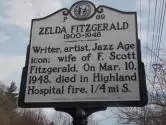Asheville’s Tragic Love Story

After the conclusion of one of my post-Arts and Crafts Conference meetings at the Grove Park Inn last week, I turned my pickup truck off Merrimon Avenue and drove up through the Asheville campus of the University of North Carolina. One of Asheville’s many unheralded gems, this four-year, liberal arts college can trace its beginnings back to 1927, but only became a part of the University of North Carolina system in 1963. To give you an idea of just what a gem it is, in the “Best Colleges of 2015” report, UNC-A is ranked #8 among all liberal arts universities nationwide.
But on this particular spring day I wasn’t on campus to do any research or to relax amid hazy memories of my own days as a carefree undergraduate back in Illinois, but to pay homage to one of the thousands who came to visit Asheville, but could never leave.
Zelda Sayre Fitzgerald arrived here in 1936, prematurely released from the mental institution in Maryland where she had been hospitalized since she and Scott returned from Switzerland in 1931. Her biographers feel Zelda suffered not only from misdiagnosed schizophrenia, but also from damaging experimental treatments, which pretty much kept her incapacitated the rest of her brief, tragic life.
While her husband desperately attempted to revive his writing career in room 441 at the Grove Park Inn, Zelda remained a patient at Highland Hospital, located on a high grassy knoll, providing her with panoramic views of the French Broad River valley and the distinctive red tile roof of the historic inn just a mile away. Scott had brought Zelda to Asheville, placing her under the care of Dr. Robert Carroll, a nationally known psychiatrist who had transformed a 1909 sanatorium into a respected mental hospital.
In 1937, Scott fled to Hollywood, leaving Zelda in the care of Dr. Carroll. In 1940, the same year that Fitzgerald died of a heart attack at the age of 44, Zelda was released, moving back to her childhood home in Alabama.
Over the course of the next few years, Zelda returned to Highland Hospital whenever she felt in need of additional treatment from Dr. Carroll and his staff. She made one such trip in March of 1948, staying in her familiar fourth floor room.
Late on the night of March 10th, a fire started in the basement kitchen of Highland Hospital. The flames were soon sucked up an open dumbwaiter shaft, quickly shooting down each hallway of the aging wooden structure. The small overnight staff struggled to get the 29 female patients out of the building and onto the safety of the lawn, but many resisted, unable to comprehend what was happening around them. Some were hampered by restraints, locked doors, or windows covered by iron bars, placed there, ironically, for their own protection. Twenty of the women, nearly all in rooms on the lower floors, were lead to safety.

By the time the Asheville firemen arrived, the four-story wooden structure was a raging inferno, visible for miles, leaving them little to do but to stand and watch. Two additional women were carried out of the building, but each died shortly thereafter from their burns. Seven other women, all in rooms on the upper floors, were unable to flee, as the wooden fire escape below them was also engulfed in flames.
One of the victims that horrific night was 48-year-old Zelda Fitzgerald, trapped by the bars over her fourth-floor windows. The following day the hospital staff was only able to identify her body by one of her charred, red ballerina slippers.
I sat for several minutes on a concrete bench on that same grassy knoll, staring out over the picturesque valley at the red tile roof of the Grove Park Inn, wondering what thoughts must have gone through Zelda Fitzgerald’s mind all those nights, knowing her husband was so close, yet always remained so far, far away.
Scott and Zelda, a tragic love story.

Until next Monday,
Make it a week to remember.
Bruce
